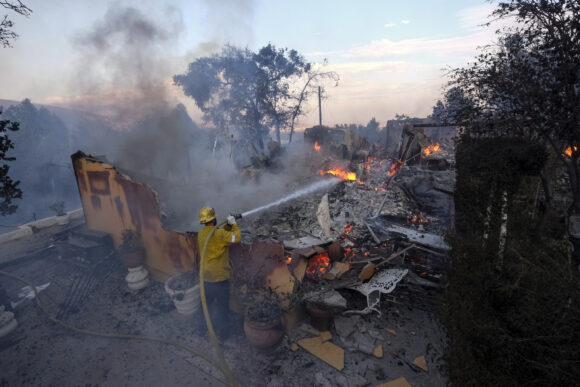LOS ANGELES (AP) — A wildfire that burned several homes near Los Angeles may signal that the region is facing the same dangers that have scorched Northern California.
The fire in San Bernardino County erupted Wednesday afternoon, quickly burned several hundred acres and damaged or destroyed at least a dozen homes and outbuildings in the foothills northeast of LA, fire officials said. Crews used shovels and bulldozers and mounted an air attack to keep the South Fire from the tiny communities of Lytle Creek and Scotland near the Cajon Pass.
Some 600 homes and other buildings were threatened along with power transmission lines, and 1,000 residents were under evacuation orders.
By nightfall, firefighters appeared to have gained the upper hand and few flames were to be seen. But the blaze was worrying because Southern California’s high fire season is typically later in the year when strong, dry Santa Ana winds blast out of the interior and flow toward the coast.
After a few cooler days, the southern region was expected to see a return of hot weather heading into the weekend. In addition to dangerously dry conditions, the region is faced with firefighting staffing that is increasingly stretched thin, said Lyn Sieliet, spokeswoman for the San Bernardino National Forest.
“Some of our firefighters that we normally have on our forests are working on fires in Northern California, or Idaho and Washington,” she told KTLA-TV. “We don’t have the full staff that we normally do.”
The largest fires in the state and in the nation were in Northern California, where they have burned down small mountain towns and destroyed huge swaths of tinder-dry forest.
The Caldor Fire destroyed some 500 homes since Aug. 14 in the Sierra Nevada southwest of Lake Tahoe, including much of the tiny hamlet of Grizzly Flats. It was 12% contained and threatened more than 17,000 structures.
Buck Minitch, a firefighter with the Pioneer Fire Protection District, was called to the fire lines last week while his wife fled their Grizzly Flats home with their two daughters, three dogs, a kitten and duffel bag of clothes, the San Jose Mercury News reported.
Hannah Minitch evacuated to her parents’ property and the next morning received a text from her husband showing only a chimney where their house once stood. The two briefly wept together during a telephone call before he got back to work.
“`We’ve got nothing left here,”’ she recalled him saying. “‘I’ve got to go protect what’s left for other people.”’
At times the wind-driven fire was burning 1,000 acres of land per hour and on Wednesday it was less than two dozen miles from Lake Tahoe, an alpine vacation and tourist spot that straddles the California-Nevada state line.
There weren’t any evacuations in Tahoe but the fire continued to cast a sickly yellow pall of smoke over the scenic region.
South Lake Tahoe and Tahoe City on the west shore had the nation’s worst air pollution at midmorning Wednesday, according to AirNow, a partnership of federal, state and local air agencies.
Meanwhile, California’s Dixie Fire, the second-largest in state history at 1,160 square miles (3,004 square kilometers), was burning only about 65 miles (104 kilometers) to the north. It was 45% contained. Some 700 homes were among nearly 1,300 buildings that have been destroyed.
In the southern Sierra Nevada, there was growing concern as the French Fire expanded near Lake Isabella, a popular fishing and boating destination. About 10 communities were under evacuation orders. The fire has blackened 32 square miles (83 square kilometers) since Aug. 18.
Smoke from the fires had fouled air farther south. The South Coast Air Quality Management District issued an advisory through Thursday morning for large portions of Los Angeles, Riverside and San Bernardino counties.
Nationally, 92 large fires were burning in 13 mainly Western states, according to the National Interagency Fire Center in Boise, Idaho.
Climate change has made the West warmer and drier in the past 30 years and will continue to make the weather more extreme and wildfires more destructive, according to scientists.
About the photo: A firefighter tries to extinguish the flames at a burning house as the South Fire burns in Lytle Creek, San Bernardino County, north of Rialto, Calif., Wednesday, Aug. 25, 2021. (AP Photo/Ringo H.W. Chiu)
Was this article valuable?
Here are more articles you may enjoy.


 NYC Tourist Helicopter Crashes in Hudson River, Killing Six
NYC Tourist Helicopter Crashes in Hudson River, Killing Six  Ireland and UK Face High Wildfire Risks After Dry, Warm Weather
Ireland and UK Face High Wildfire Risks After Dry, Warm Weather  Trump’s Tariffs Send Deliberate Shock to Heart of Global Economy
Trump’s Tariffs Send Deliberate Shock to Heart of Global Economy  Roof Repair and Replacement Costs up Nearly 30% Since 2022, Report Shows
Roof Repair and Replacement Costs up Nearly 30% Since 2022, Report Shows 